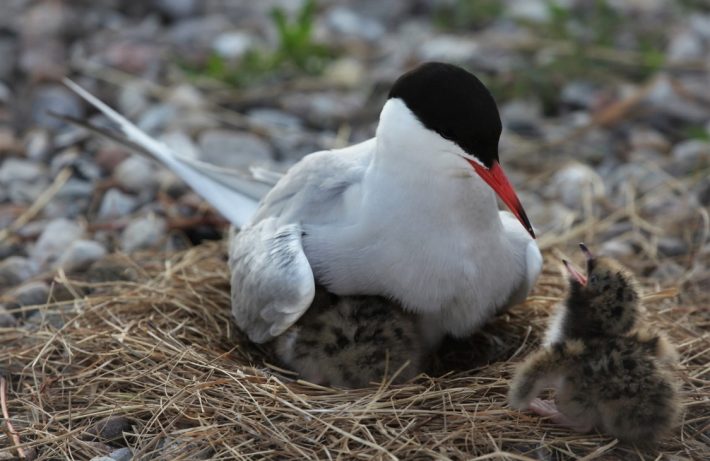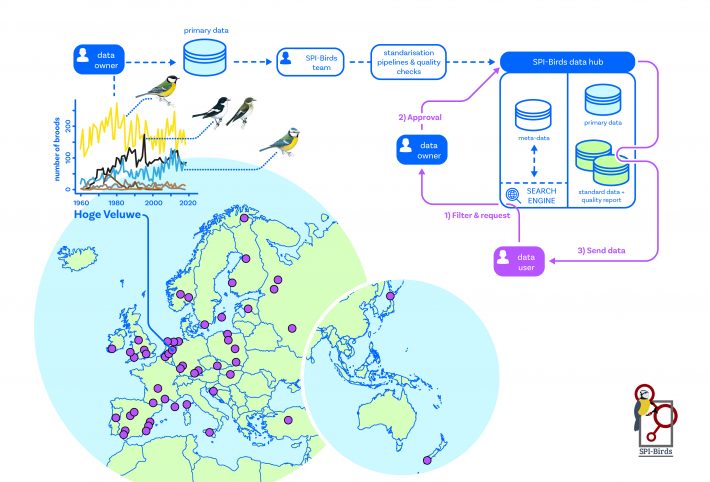Researchers publish the first scientific paper from the SPI-Birds network, a large‐scale initiative connecting data on wild populations of birds, in the Journal of Animal Ecology.

It hasn't been more than a year and a half since the international researchers' network SPI-Birds started officially. Together they collect, secure and use long-term breeding population data of 1.5 million individually recognisable birds… and counting. Big questions in ecology and evolution can be answered using this data. Today, the publication of SPI-Birds' first scientific paper in the Journal of Animal Ecology coincides with receiving the Dutch Data Incentive Prize for the Medical and Life Sciences.
"This is truly a community effort," stress both Antica Culina and Marcel Visser of the Netherlands Institute of Ecology (NIOO-KNAW). Together they form the executive board of SPI-Birds, or Studies of Populations of Individuals - Birds, a fresh but already prize-winning international research network plus database. "Behind the paper describing our initiative, there are around 120 people and 1.5 million individually marked birds from 80 populations and 19 species. And an army of people who have been collecting these data, in sunshine and rain, adding up to over 2000 seasons of fieldwork." These studies are at the core of what we know about evolutionary and ecological processes in the wild.
Researchers Culina and Visser feel honoured that SPI-Birds has received this Dutch Data prize. "The prize not only recognises the importance of the SPI initiative, but also that FAIR (Findable, Accessible, Interoperable and Reusable) data, and not necessarily Open Data, might be the most viable approach for many research communities at the moment.
Tale with a long tail
The SPI-Birds story started about three years ago. Why should combining bird data from various populations across Europe be such a hassle, wondered Culina. As a young science mum to be, the last thing she needed was something else to keep her up at night. And she was not the only one who was thinking this way. Her collaborator and two-times professor, Marcel Visser, had already worked with such long-term data sets of great tits, blue tits and other hole-breeding birds for three decennia. And he, like many others, was very well aware of the wider-felt need for a unifying database and data standard. So actually, the story is quite a bit older.
The goals were clear: preventing data loss, making it much easier for people to use the data, and increasing future data quality with a community-supported standard. And so, they finally made that happen. Visser: "SPI-Birds is important, because it allows comparative studies among populations by making the data FAIR. Converting the various data formats into a single standard data format, especially, really facilitates the use of the data."

Inspire communities
The first SPI Bird paper aims not to present scientific results, but to describe the network for new members and stakeholders, and its 'lessons learned' in order to inspire other communities. "We hope SPI-Birds will serve as an encouragement to other research communities to create their own standards," adds Culina. Other papers are in the pipeline, analysing the data to address scientific questions.
What more can we look forward to, coming out of this initiative? Visser: "Apart from the many scientific publications that will make use of SPI Birds, we also really hope that it will help to build a closer community, including standardisation of the collection of the data and the way data are used, which is very rare for phenotypic data." Culina elaborates: "The grand vision is a data landscape that connects different types of data, and helps us gain a thorough understanding of evolutionary and ecological patterns and processes in the wild."
Future tails
It's not the first time the SPI-Birds database and networking community has been recognised for its merits, and it probably won't be the last time either. The project is funded by NWO (Netherlands Organization for Scientific Research), the Centre for Biodiversity Dynamics (NTNU in Trondheim, Norway) and NIOO-KNAW. "We would also like to acknowledge the enormous efforts of all current and past fieldworkers that have contributed to the data collection."
"And who knows, in the future we might even see a SPI-Mammals or SPI-Lizards?"
You can read the full article for free here:
https://besjournals.onlinelibrary.wiley.com/doi/10.1111/1365-2656.13388






